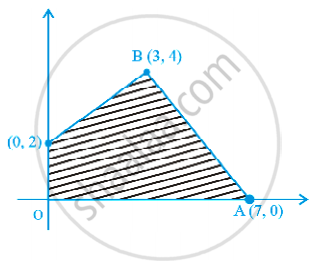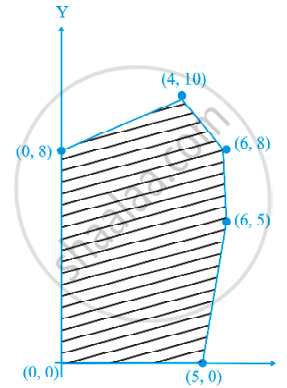Advertisements
Advertisements
Question
A company makes 3 model of calculators: A, B and C at factory I and factory II. The company has orders for at least 6400 calculators of model A, 4000 calculator of model B and 4800 calculator of model C. At factory I, 50 calculators of model A, 50 of model B and 30 of model C are made every day; at factory II, 40 calculators of model A, 20 of model B and 40 of model C are made everyday. It costs Rs 12000 and Rs 15000 each day to operate factory I and II, respectively. Find the number of days each factory should operate to minimise the operating costs and still meet the demand.
Solution
Let factory I be operated for x days and II for y days.
At factory I: 50 calculators of model A and at factory II, 40 calculators of model A are made everyday.
Company has orders of atleast 6400 calculators of model A.
∴ 50x + 40y ≥ 6400
⇒ 5x + 4y ≥ 640
Also, at factory I, 50 calculators of model B and at factory II, 20 calculators of model B are made everyday
Company has the orders of atleast 4000 of calculators of model B.
∴ 50x + 20y ≥ 4000
⇒ 5x + 2y ≥ 4000
Similarly for model C,
30x + 40y ≥ 4800
⇒ 3x + 4y ≥ 480
And x ≥ 0, y ≥ 0
It costs ₹ 12,000 and ₹ 15000 to operate the factories I and II each day.
∴ Required LPP is
Minimise Z = 12000x + 15000y subject to the constraints
5x + 4y ≥ 640 ......(i)
5x + 2y ≥ 400 .......(ii)
3x + 4y ≥ 480 .......(iii)
x ≥ 0, y ≥ 0 .......(iv)
Table for (i) equation 5x + 4y = 640
| x | 0 | 128 |
| y | 160 | 0 |
Table for (ii) equation 5x + 2y = 400
| x | 0 | 80 |
| y | 200 | 0 |
Table for (iii) equation 3x + 4y = 480
| x | 0 | 160 |
| y | 120 | 0 |

On solving equation (i) and (iii), we get
x = 80, y = 60
On solving equation (i) and (ii) we get
x = 32 and y = 120
From the graph, we see that the feasible region ABCD is open unbounded whose corners are A(160, 0), B(80, 60), C(32, 120) and D(0, 200).
Let us find the values of Z.
| Corner points | Value of Z = 12000x + 15000y | |
| A(160, 0) | Z = 12000(160) + 0 = 1920000 | |
| B(80, 60) | Z = 12000(80) + 15000(60) = 1860000 | ← Minimum |
| C(32, 120) | Z = 12000(32) + 15000(120) = 2184000 | |
| D(0, 200) | Z = 0 + 15000(200) = 3000000 |
From the above table, it is clear that the value of Z = 1860000 may or may not be minimum for an open unbounded region.
Now, to decide this, we draw a graph of 12000x + 15000y < 1860000
⇒ 4x + 5y < 620
And we have to check whether there is a common point in this feasible region or not.
So, from the graph, there is no common point.
∴ Z = 12000x + 15000y has minimum value 1860000 at (80, 60).
Factory I: 80 days
Factory II: 60 days.
APPEARS IN
RELATED QUESTIONS
Solve the following Linear Programming Problems graphically:
Minimise Z = – 3x + 4 y
subject to x + 2y ≤ 8, 3x + 2y ≤ 12, x ≥ 0, y ≥ 0.
Solve the following Linear Programming Problems graphically:
Maximise Z = 5x + 3y
subject to 3x + 5y ≤ 15, 5x + 2y ≤ 10, x ≥ 0, y ≥ 0
Show that the minimum of Z occurs at more than two points.
Maximise Z = – x + 2y, Subject to the constraints:
x ≥ 3, x + y ≥ 5, x + 2y ≥ 6, y ≥ 0.
An aeroplane can carry a maximum of 200 passengers. A profit of Rs 1000 is made on each executive class ticket and a profit of Rs 600 is made on each economy class ticket. The airline reserves at least 20 seats for executive class. However, at least 4 times as many passengers prefer to travel by economy class than by the executive class. Determine how many tickets of each type must be sold in order to maximize the profit for the airline. What is the maximum profit?
Maximise the function Z = 11x + 7y, subject to the constraints: x ≤ 3, y ≤ 2, x ≥ 0, y ≥ 0.
Feasible region (shaded) for a LPP is shown in Figure. Maximise Z = 5x + 7y.
Refer to question 15. Determine the maximum distance that the man can travel.
Refer to question 15. Determine the maximum distance that the man can travel.
The feasible solution for a LPP is shown in Figure. Let Z = 3x – 4y be the objective function. Minimum of Z occurs at ______.
Refer to Question 27. (Maximum value of Z + Minimum value of Z) is equal to ______.
In a LPP, the linear inequalities or restrictions on the variables are called ____________.
In a LPP, the objective function is always ______.
In a LPP if the objective function Z = ax + by has the same maximum value on two corner points of the feasible region, then every point on the line segment joining these two points give the same ______ value.
The feasible region for an LPP is always a ______ polygon.
In a LPP, the minimum value of the objective function Z = ax + by is always 0 if the origin is one of the corner point of the feasible region.
Z = 7x + y, subject to 5x + y ≥ 5, x + y ≥ 3, x ≥ 0, y ≥ 0. The minimum value of Z occurs at ____________.
In linear programming infeasible solutions
In linear programming, optimal solution ____________.
A maximum or a minimum may not exist for a linear programming problem if ____________.
In Corner point method for solving a linear programming problem, one finds the feasible region of the linear programming problem, determines its corner points, and evaluates the objective function Z = ax + by at each corner point. If M and m respectively be the largest and smallest values at corner points then ____________.
In Corner point method for solving a linear programming problem, one finds the feasible region of the linear programming problem, determines its corner points, and evaluates the objective function Z = ax + by at each corner point. Let M and m respectively be the largest and smallest values at corner points. In case the feasible region is unbounded, m is the minimum value of the objective function.
If two corner points of the feasible region are both optimal solutions of the same type, i.e., both produce the same maximum or minimum.
Maximize Z = 10 x1 + 25 x2, subject to 0 ≤ x1 ≤ 3, 0 ≤ x2 ≤ 3, x1 + x2 ≤ 5.
Z = 6x + 21 y, subject to x + 2y ≥ 3, x + 4y ≥ 4, 3x + y ≥ 3, x ≥ 0, y ≥ 0. The minimum value of Z occurs at ____________.
The feasible region for an LPP is shown shaded in the figure. Let Z = 3x - 4y be the objective function. Minimum of Z occurs at ____________.

Maximize Z = 10×1 + 25×2, subject to 0 ≤ x1 ≤ 3, 0 ≤ x2 ≤ 3, x1 + x2 ≤ 5.
